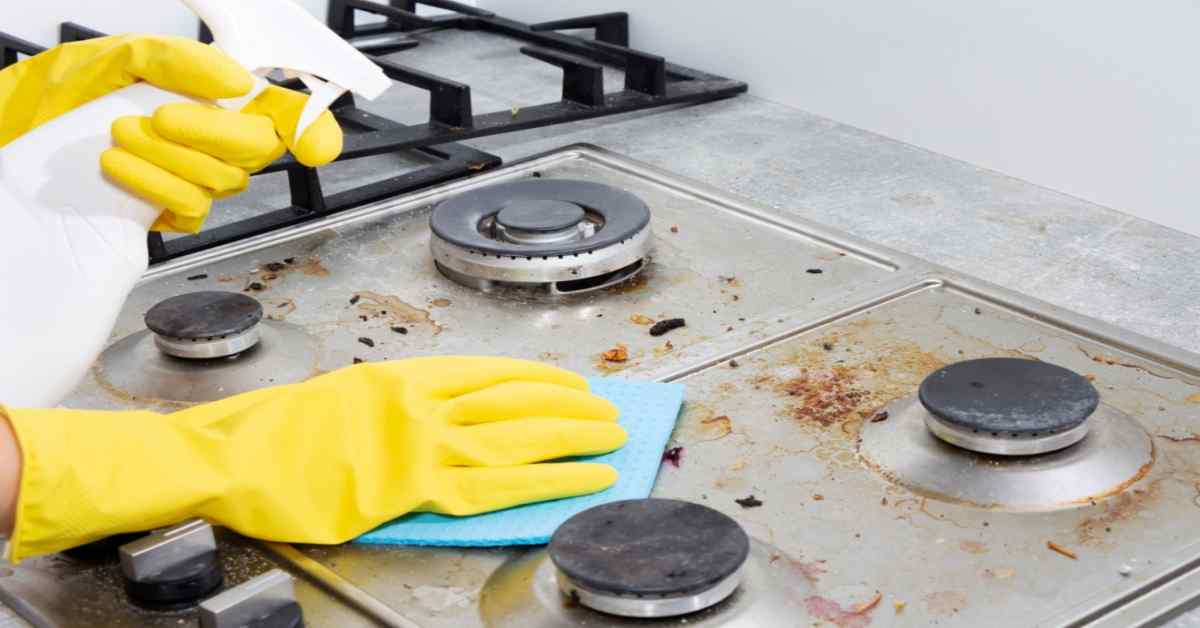Does burn-on grease and food splatters make your gas stovetop look like a war zone? Don’t worry, a clean and shiny cooktop is within reach! This guide will break down the entire process of how to clean your gas stovetop, leaving it sparkling and grease-free.

Things we covered for you
We’ll cover everything you need, from cleaning supplies to tackling tough stains, so you can reclaim your kitchen with confidence.
Read: Garage Cleaning Guide: Method, Tips and Tricks
How to Clean a Gas Stovetop: A Step-by-Step Guide
Let’s get your gas stovetop gleaming! Here’s a detailed guide to conquering the grease and grime:
Safety First!
- Always ensure the stovetop is cool before cleaning.
- Turn off the burners and disconnect the gas line if necessary (consult your manual).
Gather Your Supplies:
- Dish soap
- Baking soda (optional)
- White vinegar (optional for tougher stains)
- Spray bottle (optional)
- Soft cloths (microfiber recommended)
- Sponge
- Bucket
- Toothbrush (optional)
Disassemble the Stovetop:
- Remove the grates and burner caps according to your stovetop’s manual. These are usually removable by hand.
Clean the Grates and Burner Caps:
- Fill your sink with hot, soapy water.
- Place the grates and burner caps in the sink and let them soak for at least 15 minutes, or longer for stubborn grime.
- You can scrub the grates with a sponge or brush to remove any stuck-on food particles. For tougher stains, you can make a baking soda paste and apply it to the grime, letting it sit for a few minutes before scrubbing.
- Rinse the grates and burner caps thoroughly with clean water and dry them completely before placing them back on the stovetop.
Clean the Stovetop Surface:
- Wipe the stovetop surface with a damp cloth to remove any loose crumbs or debris.
- For light cleaning, you can use a solution of warm water and dish soap. Apply the solution to the stovetop with a damp cloth and wipe clean.
- For tougher grease and grime, you can make a paste of baking soda and water. Apply the paste to the stained areas and let it sit for 15-20 minutes. The baking soda will help to loosen the grime.
- Wipe away the baking soda paste with a damp cloth and rinse the surface with clean water.
- For stubborn burnt-on stains, you can try using a solution of white vinegar and water (50/50 mix). Spray the solution on the stain and let it sit for a few minutes before scrubbing with a damp cloth. Never mix vinegar and ammonia, as this can create harmful fumes. While commercial gas stove cleaning liquids can be effective, remember that baking soda, vinegar, and dish soap are powerful natural alternatives.
- Rinse the stovetop surface with clean water and dry it completely with a soft cloth.
Reassemble the Stovetop:
- Once the grates and burner caps are dry, place them back on the stovetop according to the manufacturer’s instructions.
Optional deep cleaning tips:
- For a very deep clean, you can use ammonia on stubborn stains. Always ensure proper ventilation when using ammonia and avoid contact with skin and eyes.
- You can also use a commercial gas stovetop cleaner following the manufacturer’s instructions.
Additional tips for cleaning gas stove top:
- Clean your gas stovetop regularly to prevent grease and grime build-up. A quick wipe-down after each use can make a big difference.
- Avoid using abrasive cleaners or scouring pads on your stovetop, as these can scratch the surface.
- Never clean your stovetop with water while it’s hot, as this could cause the surface to crack.
- A quick wipe-down after each use and a more thorough cleaning weekly, including cleaning gas stove burners, will prevent grime build-up and make cleaning a breeze.
Why You Need to Clean Gas Stove Grates and Burners
There are several important reasons to keep your gas stove grates and burners clean:
Read: NoBroker Cleaning Services Review
- Safety:
- Even flame distribution: Clogged burner holes from food debris or grease can disrupt the gas flow, leading to uneven flames. Uneven flames can be dangerous, causing pots to tip over or creating hot spots that could lead to burns.
- Proper ignition: A build-up of grease and grime around the igniters can prevent them from sparking properly, making it difficult to light the stove.
- Performance:
- Efficient cooking: Clean burners allow for optimal gas flow, resulting in a stronger and more consistent flame for efficient cooking.
- Avoids wasted gas: Clogged burners can force you to use a higher flame setting to achieve the desired heat, wasting gas in the process.
- Aesthetics and Hygiene:
- Cleanliness: A dirty stovetop with greasy grates is simply unpleasant to look at and can be a breeding ground for bacteria. Regular cleaning keeps your stove looking fresh and reduces the risk of contamination.
- Prevents lingering odours: Burnt food particles on the grates and burner caps can leave behind unpleasant odours that linger in the kitchen.
What is the Best Way to Clean the Top of a Gas Stove?
The best way to clean the top of a gas stove depends on the level of grime you’re dealing with:
Read: Home Cleaning Service in HSR Layout, Bangalore
Light Cleaning:
- For everyday cleaning of minor spills and grease splatters, a simple solution of warm water and dish soap is all you need. Apply the solution with a damp cloth and wipe clean. Dry the surface with a soft microfiber cloth to avoid streaks.
Moderate Cleaning:
- For tougher grease and grime, baking soda is your best friend. Make a paste with baking soda and a little water. Apply the paste to the stained areas and let it sit for 15-20 minutes. The baking soda will help loosen the grime. Wipe away the paste with a damp cloth and rinse the surface with clean water. Dry thoroughly with a microfiber cloth.
Heavy-Duty Cleaning:
- For stubborn burnt-on stains, white vinegar can be a lifesaver. Create a 50/50 mix of white vinegar and water. Spray the solution on the stain, let it sit for a few minutes, and then scrub with a damp cloth. Important note: Never mix vinegar and ammonia, as this can create harmful fumes.
- Alternatively, you can use a commercial gas stove top cleaner following the manufacturer’s instructions. Always ensure proper ventilation when using any harsh chemicals and avoid contact with skin and eyes.
Tips for Maintaining a Clean Stovetop
Here are some tips for maintaining a clean stovetop:
- Quick Cleaning After Each Use:
- Wipe up spills immediately: Don’t let spills sit and harden. Grab a damp cloth and wipe them up as soon as you’re done cooking. This will prevent them from becoming baked-on messes later.
- Daily wipe-down: After each use, take a minute to wipe down the entire stovetop surface with a damp microfiber cloth. This will remove any grease splatters or food debris before they have a chance to solidify.
- Weekly Deep Clean:
- Schedule a weekly cleaning session: Set aside sometime each week to give your stovetop a more thorough clean. This will involve removing the grates and burner caps for soaking and scrubbing, and cleaning the cooktop surface with baking soda, vinegar, or a commercial cleaner depending on the level of grime.
- Smart Cooking Practices:
- Use pot lids: Whenever possible, use pot lids to contain splatters and prevent grease from escaping. This will significantly reduce the amount of cleaning required on the stovetop surface.
- Low and slow is the way to go: Avoid using extremely high heat settings, as this can lead to more splattering and burning. Opt for lower heat and simmering whenever possible.
- Preventative Measures:
- Line your oven with a drip pan: Placing a drip pan on the bottom rack of your oven can catch any drips or spills that may overflow from pots during cooking. This will prevent them from dripping down onto the stovetop below.
- Keep a box of baking soda handy: Baking soda is a natural cleaning powerhouse and a safe option for most stovetops. Keep a box on hand for quick cleaning of minor spills or grease splatters.
How to Choose Budget-Friendly Options?
Here’s how to consider budget-friendly options when cleaning your gas stovetop:
- Cleaning Supplies:
- Skip fancy cleaners: You likely already have most of what you need for effective stovetop cleaning at home. Opt for natural cleaning solutions like white vinegar and baking soda instead of expensive commercial cleaners.
- Dish soap and water: This is a great first line of defence for everyday cleaning.
- Baking soda powerhouse: Baking soda is a natural degreaser and can tackle most grease and grime issues. Make a baking soda paste with a little water for tougher stains.
- Repurpose household items: An old toothbrush can be a great tool for scrubbing around the burner caps and grates.
- Cleaning Techniques:
- Focus on preventative cleaning: Quick wipe-downs after each use with a damp cloth can prevent spills from becoming baked-on messes later, minimising the need for heavy-duty cleaning products.
- Elbow grease over harsh chemicals: For tougher stains, a little scrubbing with baking soda paste or a vinegar solution can often be more effective than harsh chemical cleaners.
- Soak it to you: Heavily soiled grates and burner caps can be soaked in hot, soapy water for at least 15 minutes before scrubbing. This loosens grime and makes cleaning much easier, reducing the need for abrasive scrubbing or harsh chemicals.
How NoBroker Can Help
With a little routine maintenance and these budget-friendly cleaning tips, you can keep your gas stovetop looking shiny and grease-free!
Need a refresher on how to clean gas stove tops? NoBroker can connect you with trusted and reliable cleaning services in your area! We’ll take care of the scrubbing and degreasing, leaving you more time to relax and enjoy your sparkling-clean kitchen.
To know more visit the NoBroker website today to find a cleaning service provider near you!
Frequently Asked Questions
For a quick clean of gas stove burners: Remove grates, and soak in soapy water. Wipe burners with soapy water, and use baking soda paste for tough grime. Rinse, dry, reassemble.
To clean gas stove burner heads: remove them (cool stove first!), soak in soapy water, scrub with baking soda paste for tough grime, rinse, and dry completely before reassembling.
For a quick glass stovetop clean: cool the surface, then spray with vinegar solution (water + vinegar), sprinkle baking soda, apply a warm wet towel for 10-15 minutes, and wipe clean with a microfiber cloth. Buff with another dry microfiber cloth for a streak-free finish.
Turn off the burners and let the cooktop cool completely before cleaning. Never use abrasive cleaners or scouring pads, as these can scratch the surface. Opt for mild dish soap, baking soda, white vinegar, or a commercial cooktop cleaner.
Use a toothpick or a thin wire brush (like the one from a pipe cleaner) to carefully remove any food debris or clogs from the burner holes. Never use anything sharp or metallic, as this can damage the igniters.














